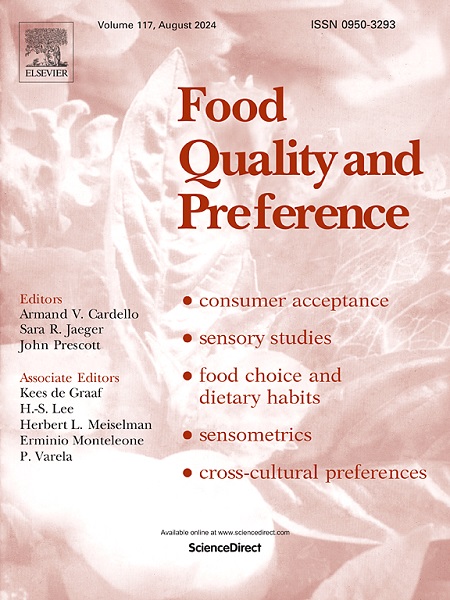利用广义普洛克氏分析法了解全球描述性感官面板的文化差异
IF 4.9
1区 农林科学
Q1 FOOD SCIENCE & TECHNOLOGY
引用次数: 0
摘要
本研究探讨了文化差异对全球描述性感官面板的有效性和可比性的影响。横跨三大洲(亚洲、欧洲和北美)的六个感官小组使用MMR的描述性分析方法评估了六种草莓奶糖产品的感官概况。每个感觉面板都发展了自己的感觉语言和尺度,从而允许探索区域差异。应用广义普氏分析,将所有面板数据对齐到一致的感觉空间并比较结果。研究结果表明,由于区分产品的关键感官属性评级的一致性,产品在各个面板上的总体相似性和差异性具有良好的一致性。在大多数其他属性上,包括水果口味和强度较低的口味,观察到面板之间的差异。区域差异部分是由于文化熟悉,感觉面板使用当地相关的语言和参考。与来自亚洲,尤其是印度的小组相比,来自欧洲和北美的小组表现出更紧密的联系。调查结果强调了小组培训的重要性,并强调了使全球小组保持一致的重点领域。具体来说,训练低强度属性、水果风味、更清晰的定义和标准化的纹理属性评估协议。这种方法可以减轻文化差异的影响,促进全球感官评估的可比性,提高这些评估在全球背景下的可靠性和适用性。这项工作为有效的全球感官评估策略的发展提供了见解。本文章由计算机程序翻译,如有差异,请以英文原文为准。
Understanding cultural differences across global descriptive sensory panels using Generalized Procrustes Analysis
This study investigates the implications of cultural differences on the effectiveness and comparability of global descriptive sensory panels. Six sensory panels spanning three continents (Asia, Europe and North America) evaluated the sensory profiles of six strawberry milk candy products using MMR's descriptive analysis methodology. Each sensory panel developed their own sensory language and scaling, thus allowing for regional differences to be explored. Generalized Procrustes Analysis was applied, to align all the panel data into a consensus sensory space and compare the results.
The findings demonstrated good alignment in the overall similarities and differences of the products across the panels, due to consistency in the ratings of the key sensory attributes that differentiated the products. Differences were observed across the panels in most other attributes, including fruit flavors and those with lower intensities. Regional differences were, in part, due to cultural familiarity, with sensory panels using locally relevant language and references. Panels from Europe and North America demonstrated closer alignment with one another, compared to those from Asia, especially the Indian panel.
The findings emphasize the importance of panel training and highlight areas of focus to align panels globally. Specifically, training on lower intensity attributes, fruit flavors, and clearer definitions and standardized evaluation protocols for texture attributes. This approach can mitigate the influence of cultural nuances and foster comparability in global sensory evaluations, enhancing the reliability and applicability of these assessments in a global context. This work offers insights into the development of effective global sensory evaluation strategies.
求助全文
通过发布文献求助,成功后即可免费获取论文全文。
去求助
来源期刊

Food Quality and Preference
工程技术-食品科技
CiteScore
10.40
自引率
15.10%
发文量
263
审稿时长
38 days
期刊介绍:
Food Quality and Preference is a journal devoted to sensory, consumer and behavioural research in food and non-food products. It publishes original research, critical reviews, and short communications in sensory and consumer science, and sensometrics. In addition, the journal publishes special invited issues on important timely topics and from relevant conferences. These are aimed at bridging the gap between research and application, bringing together authors and readers in consumer and market research, sensory science, sensometrics and sensory evaluation, nutrition and food choice, as well as food research, product development and sensory quality assurance. Submissions to Food Quality and Preference are limited to papers that include some form of human measurement; papers that are limited to physical/chemical measures or the routine application of sensory, consumer or econometric analysis will not be considered unless they specifically make a novel scientific contribution in line with the journal''s coverage as outlined below.
 求助内容:
求助内容: 应助结果提醒方式:
应助结果提醒方式:


